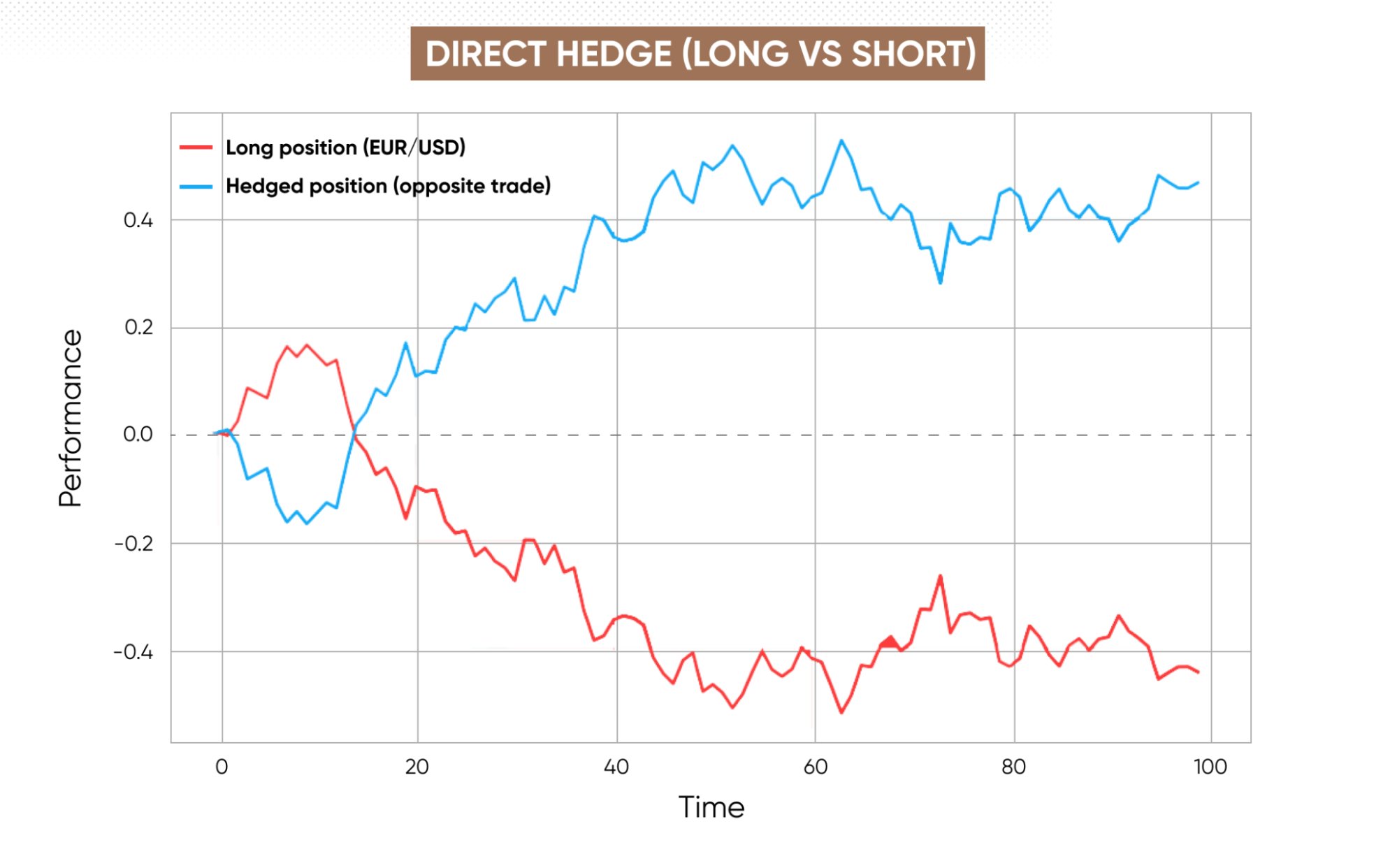A trader’s guide to hedging

Learn about hedging in trading, with strategies, tips and examples of how to manage risk effectively with Capital.com.
What is hedging?
Hedging is a risk-management trading strategy where positions are opened to offset potential losses in an existing position or portfolio. It works like insurance for your trades, reducing risk if the market moves against you. While hedging may reduce potential losses, it can also limit gains, so there’s a risk-reward tradeoff.
Hedging can be used in derivatives trading, like CFDs or spread betting– where leverage increases both potential gains and losses.
How does hedging work?
Hedging works across all asset classes, including forex, indices, commodities and shares. It involves opening new trades to counterbalance the risk of your existing positions.
For example, if you hold a large long position on a stock, you might open a short position on another, negatively correlated asset to protect yourself from downward price movement.
While hedging is considered a useful risk management strategy, it does not guarantee protection against losses, as past performance does not guarantee future results.
Benefits and disadvantages of hedging
Hedging offers benefits like effective risk management, portfolio protection, and the flexibility to safeguard against adverse market movements. However, it also comes with disadvantages such as increased costs, limited profit potential, and the need for careful asset selection. All these factors should be carefully evaluated when considering a hedging strategy.
Benefits
- Helps manage and reduce risk, especially in volatile markets.
- Can protect against overconcentration in a few assets.
- Can be applied across various markets, from stocks and indices, to forex and commodities.
Disadvantages
- Limits potential gains as well as losses.
- Involves additional costs, like fees or spreads, which can reduce overall profitability.
- Does not guarantee full protection – especially against major market shifts.
Types of hedging in trading
Here are some of the most common forms of hedging used by traders.
Direct hedging
Direct hedging means opening both a long and short position on the same asset simultaneously. For example, if you're long on a share CFD but expect short-term volatility, you can open a short position on the same asset to offset potential losses. This strategy allows traders to hedge without closing their original trade.

Past performance is not a reliable indicator of future results
Spread hedging
Hedging strategies that involve two or more related assets are known as ‘spread hedging’.
Spread hedging is when a trader opens two or more positions in price correlated or similar assets. The goal of spread hedging is to make gains from price differences between related assets, while limiting the impact of adverse market movements.
Cross-asset hedging
Cross-asset hedging involves hedging by taking positions in correlated assets. For instance, if you're long on gold CFDs, you might hedge by shorting a commodity like silver or an index that correlates with gold prices. This strategy allows traders to balance risk across related markets.
Pairs hedging
Pairs hedging is when you take opposite positions in two positively price-correlated assets that often move in the same direction. In this strategy, traders seek to benefit from short-term price divergences on the assumption of mean reversion, that the assets will eventually revert to their historical average price relationship.
For example, there are two positively correlated assets. One is overvalued and the other undervalued compared to the historical average. In this scenario, traders may place a hedge trade by going long on the undervalued asset and short on the overvalued one.
Some notable stocks that have shown periods of historical positive correlation include Apple and Microsoft (technology), Visa and Mastercard (finance) and Coca-Cola and PepsiCo (beverages), although correlations are not exact and depend on market conditions.
Safe-haven assets
Safe-haven assets are often thought to retain or even increase their value during market instability. Traders might choose these assets in anticipation of a broader market downtrend, for example during times of economic uncertainty or volatility.
Markets with a historical reputation for being safe-haven assets include gold, which often has a negative correlation with stock markets and the US dollar during economic downturns – and the Swiss franc, which has an association of stability, due to Switzerland’s stable economy and financial system.
Again, markets may often repeat their historical behaviours, but safe-haven assets are not a guarantee against loss. Past performance does not guarantee future results.
How to hedge a trade
Evaluate your exposure
Assess your open positions and analyse market conditions. Determine your potential losses from market events such as company financial statements that could impact stock prices, or economic indicators and interest rate decisions that might move commodity or forex pair prices.
Choose a hedge type and strategy
Decide which type of hedge suits your trading preferences and existing positions. Common strategies include direct hedging, spread hedging, cross-asset trading and pairs trading.
Select an appropriate asset class
Pick an asset that has the potential to balance out your risk. This could involve stocks, indices, commodities or forex currency pairs that have an inverse price relationship with your original position.
Pick a market
CFD hedging strategies often involve taking opposing positions on two assets that are negatively correlated. Financial derivatives, such as contracts for difference (CFDs), are particularly well-suited for hedge trading, as they allow traders to speculate on both rising and falling markets. Remember that CFDs come with significant risk due to leverage, which can magnify both potential gains and losses.
Implement risk management controls
Protect potential gains and manage your exposure to loss by establishing safeguards such as stop-loss and take-profit orders. Use technical analysis to identify key resistance and support levels – as well as overbought or oversold conditions – to optimise your controls to respond to market shifts effectively.
Monitor market conditions
Keep an eye on market trends, economic indicators and news events – such as geopolitical developments and industry-specific news – that could affect your positions, and adjust your hedge as needed.
Practise with a demo account
Prepare yourself and try trading on a demo account. Trusted online trading platforms offer a demo account, where you can practise trading CFDs on live markets, risk-free, using virtual money.
Hedging strategies and techniques
There are various hedging strategies you can use in an attempt to reduce risk during volatile markets. Various techniques, like direct hedging, cross-asset hedging, and investing in safe haven assets, help offset potential losses. These strategies allow traders to protect their portfolios while still maintaining opportunities for profit.
Direct hedging strategy
Let’s say you hold a long position in EUR/USD through a CFD, but concerns about short-term volatility arise due to upcoming US economic data. Instead of closing the long position, you open a short position in EUR/USD with a CFD. If the currency pair drops, the short position offsets the losses in the long position, minimising the overall risk without exiting the original trade.
Spread hedging strategy
You’re a commodities trader concerned about the fluctuating price of crude oil. You open a long position on a crude oil CFD while simultaneously shorting a gasoline CFD. Since gasoline prices are linked to crude oil but move differently due to refining processes, the spread between these two positions provides a hedge. If crude oil rises but gasoline lags, the trader profits from the crude oil position, while the short gasoline position limits potential losses if refining margins tighten.
Cross-asset hedging strategy
You hold a long position on a share CFD during a volatile economic period. To hedge against potential losses in the stock market, you open a short position on a gold CFD, a commodity that historically has often moved inversely to shares during market downturns. If the stock market declines, the rising price of gold helps offset losses in the equity positions, effectively reducing risk during market turbulence.
Safe haven hedging strategy
You have significant exposure to volatile tech stocks via CFDs, and are concerned about a potential market crash. You decide to allocate part of your portfolio to safe haven assets like Swiss francs (CHF). These assets typically retain or increase value during periods of market uncertainty. If the stock market crashes, the safe haven assets provide a hedge, theoretically preserving your capital and stabilising your portfolio.
Pairs hedging strategy
You identify that stock A and stock B in the tech sector usually move together. However, due to short-term news, stock A has dropped in price while stock B has remained stable. Believing that the prices will converge, you go long on stock A (expecting it to rise) with a CFD and short on stock B with a CFD (expecting it to fall or underperform). If stock A rebounds and stock B drops or remains stagnant, you may profit from the narrowing of the spread between the two stocks.
FAQ
What is hedging in trading?
Hedging involves risk management strategies where traders open trades with the aim of offsetting the potential risks of one or more existing positions, with the drawback of reducing possible gains too.
What are some common hedging strategies?
Hedging strategies include direct hedging, where traders open opposite positions on the same asset – and pairs hedging, which involves taking long and short positions on two correlated assets. Other methods include trading safe haven assets – like gold – and diversification across asset classes.
How do I start hedge trading?
Open an account with a broker who offers hedging instruments like CFDs or spread betting. Learn about the markets and the basics of trading, then develop a risk management strategy that includes hedging, stop-loss and take-profit orders, and consider practising on a demo account.